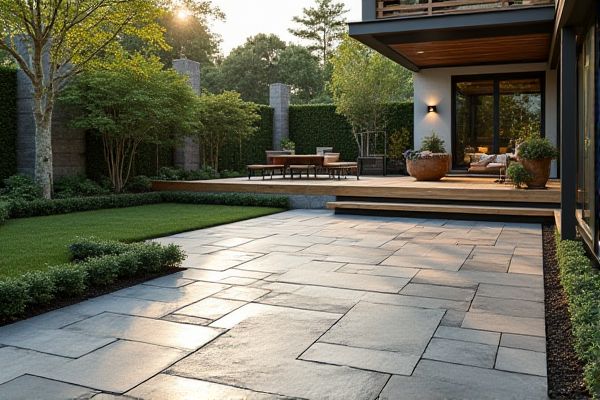
Deck tiles offer a quick, affordable way to enhance outdoor spaces with easy installation and various design options, while pavers provide durable, long-lasting surfaces ideal for high-traffic areas and greater customization. Explore the benefits and drawbacks of deck tiles and pavers to determine which solution best fits Your outdoor renovation needs in the rest of this article.
Table of Comparison
| Feature | Deck Tiles | Pavers |
|---|---|---|
| Material | Wood, composite, or plastic | Concrete, stone, brick |
| Installation | Easy, click-lock or interlocking system | Labor-intensive, requires sand base and mortar |
| Durability | Moderate; weather-resistant but may fade or warp | High; strong and long-lasting under heavy traffic |
| Maintenance | Low; occasional cleaning and sealing | Moderate; weed control and occasional re-leveling |
| Cost | Medium; DIY-friendly | Varies; higher due to labor and materials |
| Design Flexibility | Modular, easy to change | Wide variety of shapes and patterns |
| Best Use | Balconies, rooftops, temporary setups | Driveways, patios, walkways |
Introduction to Deck Tiles and Pavers
Deck tiles and pavers offer versatile solutions for enhancing outdoor spaces with distinct materials and installation methods. Deck tiles, typically made from wood, composite, or stone, provide quick and easy installation with a focus on modularity and aesthetic appeal. Pavers, often constructed from concrete, brick, or natural stone, are durable and suitable for creating permanent, solid surfaces ideal for patios, walkways, and driveways.
Material Composition: Deck Tiles vs Pavers
Deck tiles are commonly made from composite materials, wood, or bamboo, offering flexibility, easy installation, and resistance to weathering while maintaining a lightweight structure. Pavers generally consist of concrete, stone, or brick, providing superior durability, heavy load-bearing capacity, and a solid foundation for outdoor surfaces. Material composition differences directly impact factors like installation process, maintenance requirements, and overall longevity in various climate conditions.
Installation Process Compared
Deck tiles offer a quick, DIY-friendly installation with interlocking systems that require minimal tools and no specialized skills, making them ideal for homeowners seeking a hassle-free upgrade. Pavers involve a more labor-intensive process including site excavation, laying a stable base, and precise alignment, often necessitating professional expertise. Your choice hinges on whether you prioritize speed and ease or durability and customization in your outdoor flooring project.
Aesthetic and Design Options
Deck tiles offer a versatile range of aesthetic and design options with easy installation patterns, available in materials like wood, composite, and stone that create a modern, modular look. Pavers provide a classic, durable aesthetic with extensive customization through shapes, colors, and patterns such as herringbone or basketweave, perfect for creating timeless elegance. Choosing deck tiles or pavers depends on your desired visual style and how you want your outdoor space to complement your overall landscape design.
Durability and Longevity
Deck tiles typically offer moderate durability, suitable for light to medium foot traffic, but may wear down faster under harsh weather conditions compared to pavers. Pavers, made from materials like concrete, stone, or brick, are engineered for high durability and can withstand heavy loads, extreme temperatures, and moisture over many years. Choosing pavers will enhance your outdoor space's longevity and reduce maintenance needs, making them an ideal investment for long-term durability.
Maintenance Requirements
Deck tiles require minimal maintenance, needing occasional cleaning with mild soap and water to prevent dirt buildup and mildew. Pavers demand more upkeep, including regular sealing to protect against stains and weed growth between joints. Your choice depends on whether you prefer low-maintenance convenience or a more traditional, customizable surface.
Cost Comparison: Deck Tiles vs Pavers
Deck tiles typically cost between $5 and $15 per square foot, offering a budget-friendly and easy-to-install option for enhancing outdoor spaces. Pavers generally range from $10 to $30 per square foot, reflecting higher material and installation expenses due to labor-intensive processes. Your choice will depend on balancing upfront costs with durability and aesthetic preferences for long-term outdoor flooring solutions.
Slip Resistance and Safety
Deck tiles offer enhanced slip resistance due to their textured surfaces and materials like composite or rubber, making them safer for wet conditions. Pavers, typically made from stone or concrete, can become slippery when wet unless treated with anti-slip coatings or textured finishes. Choosing the right material depends on the specific environment and safety requirements, with deck tiles generally providing better traction for residential decks and poolside areas.
Environmental Impact
Deck tiles made from sustainable materials like bamboo or recycled plastics offer a lower environmental footprint compared to traditional concrete pavers, which require energy-intensive manufacturing and emit significant CO2. Permeable deck tiles allow better water drainage, reducing runoff and soil erosion, whereas impervious pavers often contribute to increased surface water pollution. Choosing eco-friendly deck tiles supports resource conservation and minimizes landfill waste, making them a greener alternative for outdoor flooring.
Best Applications and Recommendations
Deck tiles are best suited for temporary or elevated outdoor spaces like balconies and rooftop decks due to their easy installation and lightweight design. Pavers offer superior durability and load-bearing capacity, making them ideal for driveways, walkways, and patios with heavy foot traffic or vehicle use. For areas requiring quick updates or seasonal modifications, deck tiles provide versatility, whereas pavers deliver long-term stability and natural aesthetics in landscape architecture.
 homyna.com
homyna.com